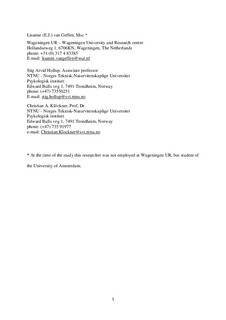| dc.contributor.author | Van Geffen, Lisanne | |
| dc.contributor.author | Hollup, Stig Arvid | |
| dc.contributor.author | Kløckner, Christian | |
| dc.date.accessioned | 2017-10-09T09:01:29Z | |
| dc.date.available | 2017-10-09T09:01:29Z | |
| dc.date.created | 2016-12-14T17:26:00Z | |
| dc.date.issued | 2016 | |
| dc.identifier.citation | Psyecology. 2016, 7 (3), 262-281. | nb_NO |
| dc.identifier.issn | 2171-1976 | |
| dc.identifier.uri | http://hdl.handle.net/11250/2459110 | |
| dc.description.abstract | In a pioneering work, this study explores the potential that may be found in combining the environmental psychological concept environmental worldview with the neurocognitive study technique electroencephalography (EEG). With this research, we aim to bridge between the research traditions of environmental communication and neuro-cognition by investigating in an qEEG experiment (N = 19) if different levels of environmental worldview, measured by the NEP, influence the processing of visual climate change imagery, reflected by the theta and gamma oscillations in the frontal and parietal areas. Our results confirm the assumptions that there is a relationship between the degree of environmental worldview and visual environmental communication processing. The pattern is interpreted as an indication that people with weak pro-environmental worldviews show cognitive signs of mismatch between what is in line with their environmental worldview and what they are confronted with in the visual stimulus. | nb_NO |
| dc.language.iso | eng | nb_NO |
| dc.publisher | Taylor & Francis | nb_NO |
| dc.relation.uri | http://www.tandfonline.com/doi/pdf/10.1080/21711976.2016.1242229?needAccess=true | |
| dc.title | How do people with weak and strong pro-environmental worldviews process visual climate change information? An EEG study | nb_NO |
| dc.type | Journal article | nb_NO |
| dc.type | Peer reviewed | nb_NO |
| dc.description.version | acceptedVersion | nb_NO |
| dc.source.pagenumber | 262-281 | nb_NO |
| dc.source.volume | 7 | nb_NO |
| dc.source.journal | Psyecology | nb_NO |
| dc.source.issue | 3 | nb_NO |
| dc.identifier.doi | 10.1080/21711976.2016.1242229 | |
| dc.identifier.cristin | 1412978 | |
| dc.description.localcode | This is an accepted manuscript of an article published by Taylor & Francis in Psyecology on 16 Nov 2016, available at http://www.tandfonline.com/doi/full/10.1080/21711976.2016.1242229 | nb_NO |
| cristin.unitcode | 194,67,40,0 | |
| cristin.unitname | Institutt for psykologi | |
| cristin.ispublished | true | |
| cristin.fulltext | postprint | |
| cristin.qualitycode | 1 | |
